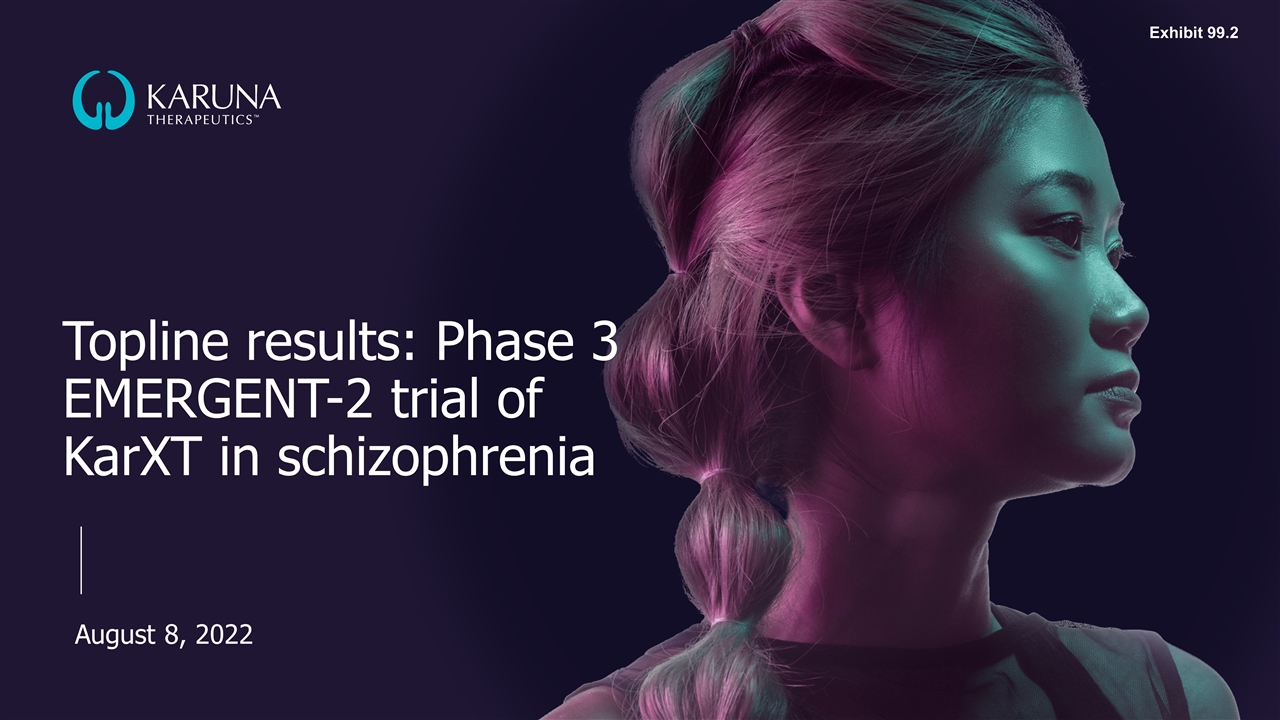
Topline results: Phase 3 EMERGENT-2 trial of KarXT in schizophrenia August 8, 2022 Exhibit 99.2
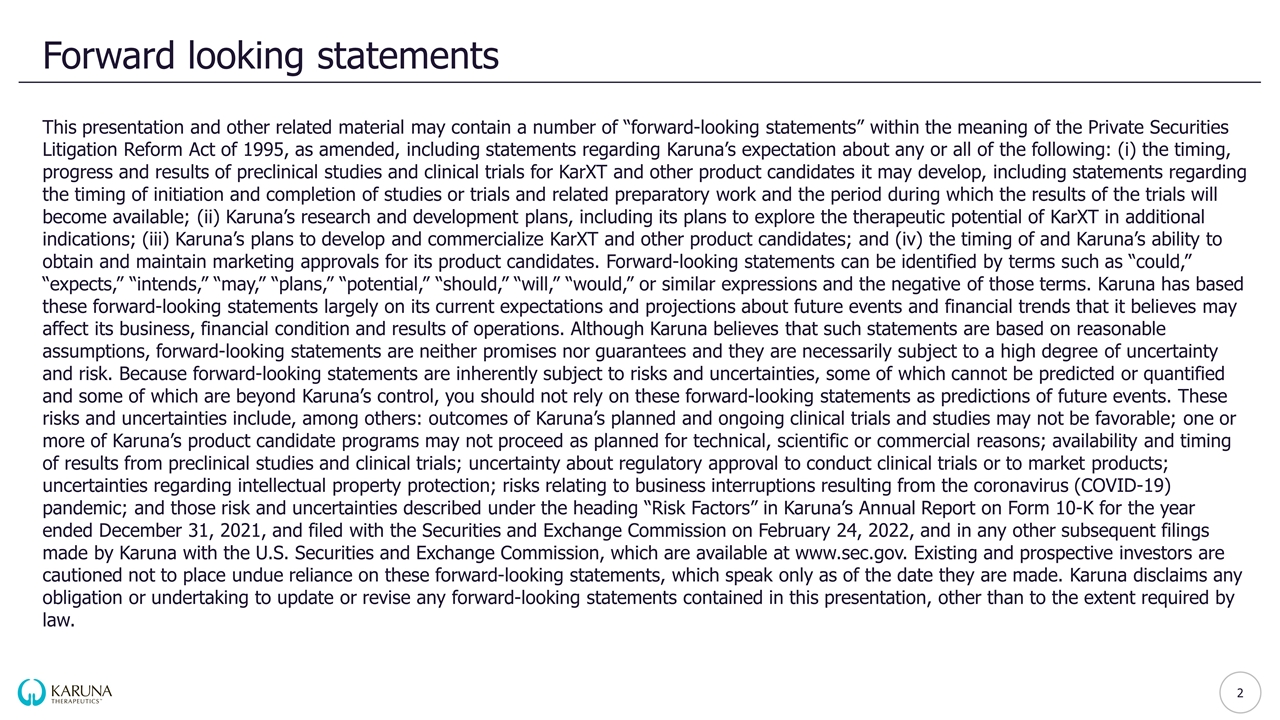
Forward looking statements This presentation and other related material may contain a number of “forward-looking statements” within the meaning of the Private Securities Litigation Reform Act of 1995, as amended, including statements regarding Karuna’s expectation about any or all of the following: (i) the timing, progress and results of preclinical studies and clinical trials for KarXT and other product candidates it may develop, including statements regarding the timing of initiation and completion of studies or trials and related preparatory work and the period during which the results of the trials will become available; (ii) Karuna’s research and development plans, including its plans to explore the therapeutic potential of KarXT in additional indications; (iii) Karuna’s plans to develop and commercialize KarXT and other product candidates; and (iv) the timing of and Karuna’s ability to obtain and maintain marketing approvals for its product candidates. Forward-looking statements can be identified by terms such as “could,” “expects,” “intends,” “may,” “plans,” “potential,” “should,” “will,” “would,” or similar expressions and the negative of those terms. Karuna has based these forward-looking statements largely on its current expectations and projections about future events and financial trends that it believes may affect its business, financial condition and results of operations. Although Karuna believes that such statements are based on reasonable assumptions, forward-looking statements are neither promises nor guarantees and they are necessarily subject to a high degree of uncertainty and risk. Because forward-looking statements are inherently subject to risks and uncertainties, some of which cannot be predicted or quantified and some of which are beyond Karuna’s control, you should not rely on these forward-looking statements as predictions of future events. These risks and uncertainties include, among others: outcomes of Karuna’s planned and ongoing clinical trials and studies may not be favorable; one or more of Karuna’s product candidate programs may not proceed as planned for technical, scientific or commercial reasons; availability and timing of results from preclinical studies and clinical trials; uncertainty about regulatory approval to conduct clinical trials or to market products; uncertainties regarding intellectual property protection; risks relating to business interruptions resulting from the coronavirus (COVID-19) pandemic; and those risk and uncertainties described under the heading “Risk Factors” in Karuna’s Annual Report on Form 10-K for the year ended December 31, 2021, and filed with the Securities and Exchange Commission on February 24, 2022, and in any other subsequent filings made by Karuna with the U.S. Securities and Exchange Commission, which are available at www.sec.gov. Existing and prospective investors are cautioned not to place undue reliance on these forward-looking statements, which speak only as of the date they are made. Karuna disclaims any obligation or undertaking to update or revise any forward-looking statements contained in this presentation, other than to the extent required by law.
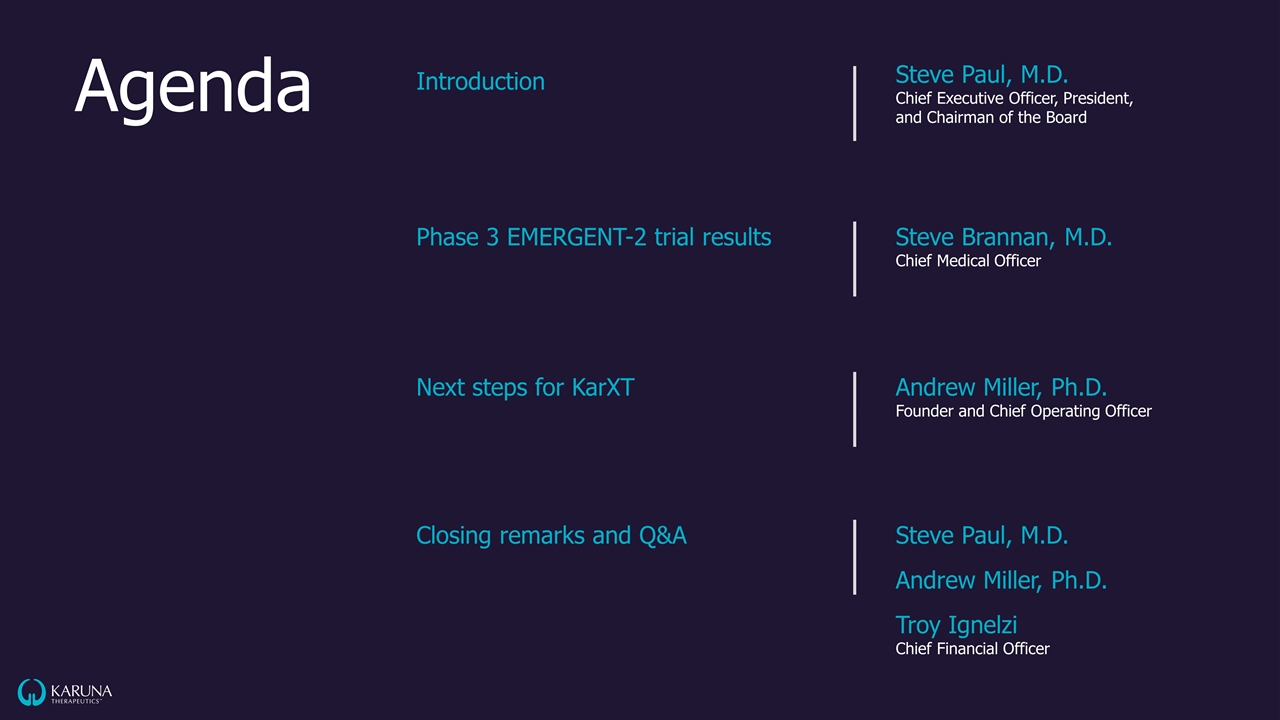
Introduction Steve Paul, M.D. Chief Executive Officer, President, and Chairman of the Board Phase 3 EMERGENT-2 trial results Steve Brannan, M.D. Chief Medical Officer Next steps for KarXT Andrew Miller, Ph.D. Founder and Chief Operating Officer Closing remarks and Q&A Steve Paul, M.D. Andrew Miller, Ph.D. Troy Ignelzi Chief Financial Officer Agenda
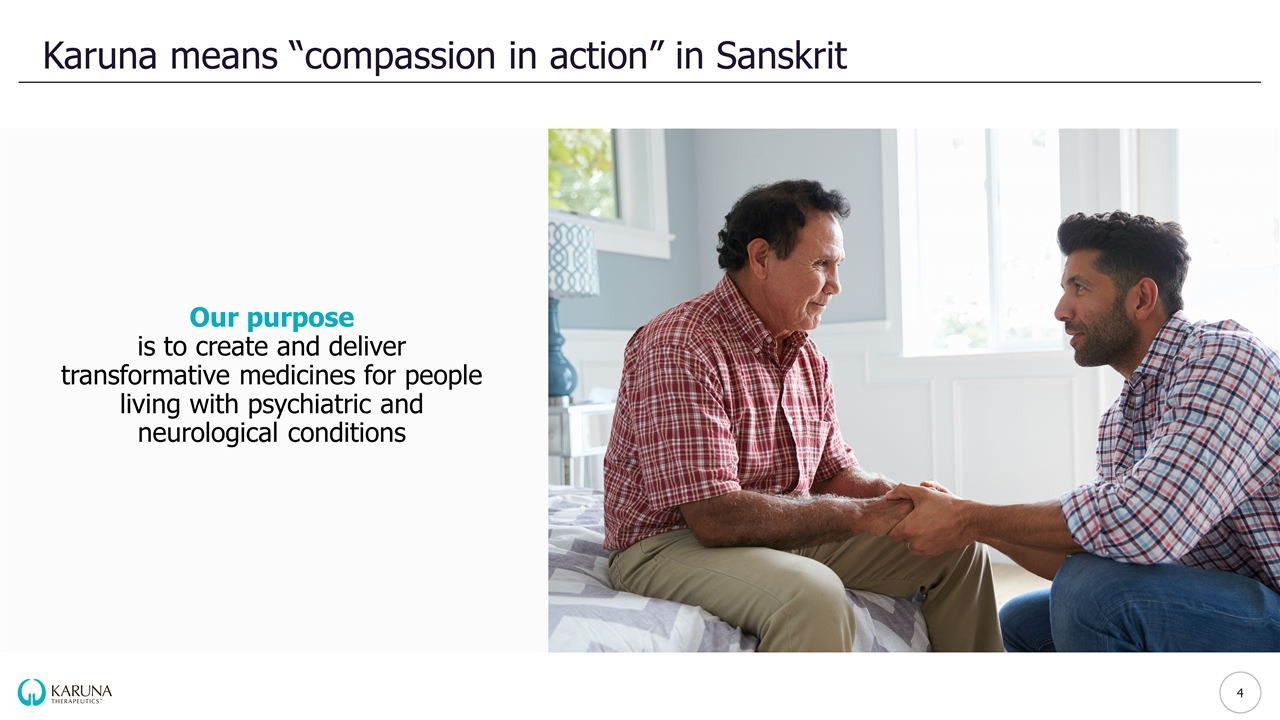
Karuna means “compassion in action” in Sanskrit Our purpose is to create and deliver transformative medicines for people living with psychiatric and neurological conditions
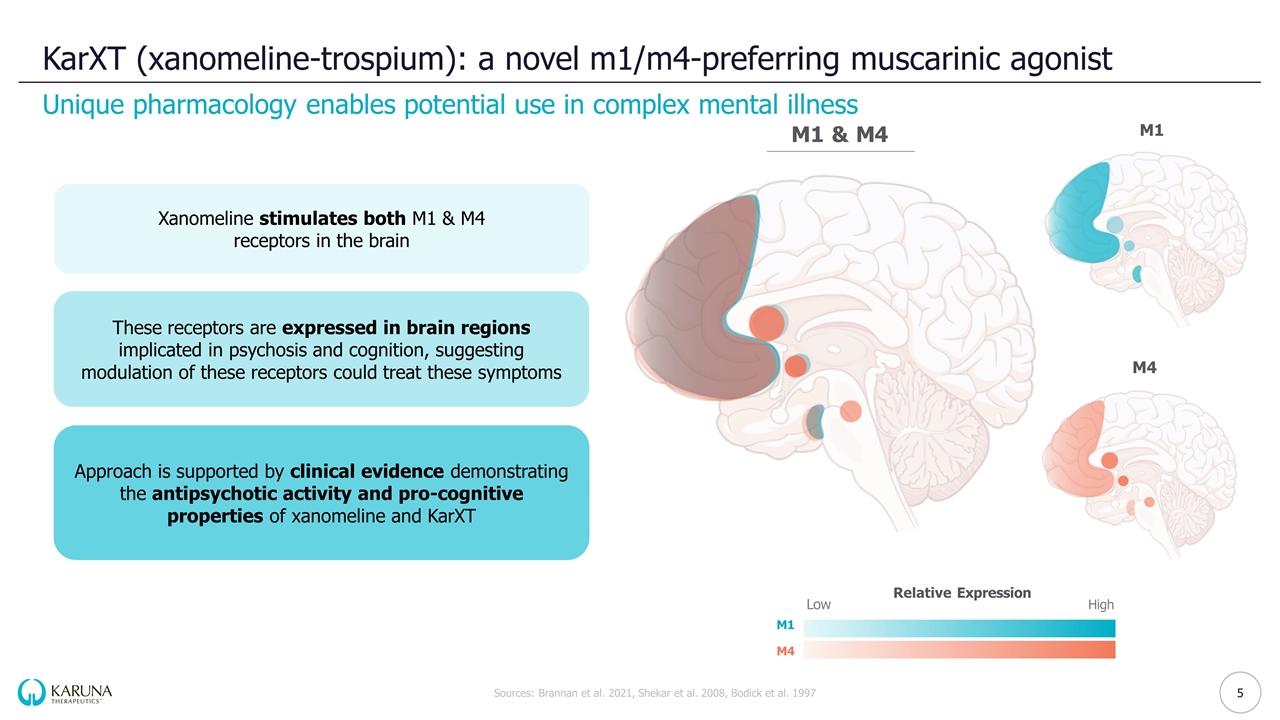
KarXT (xanomeline-trospium): a novel m1/m4-preferring muscarinic agonist Sources: Brannan et al. 2021, Shekar et al. 2008, Bodick et al. 1997 Unique pharmacology enables potential use in complex mental illness Xanomeline stimulates both M1 & M4 receptors in the brain These receptors are expressed in brain regions implicated in psychosis and cognition, suggesting modulation of these receptors could treat these symptoms Approach is supported by clinical evidence demonstrating the antipsychotic activity and pro-cognitive properties of xanomeline and KarXT M1 & M4 Relative Expression Low High M1 M4 M1 M4
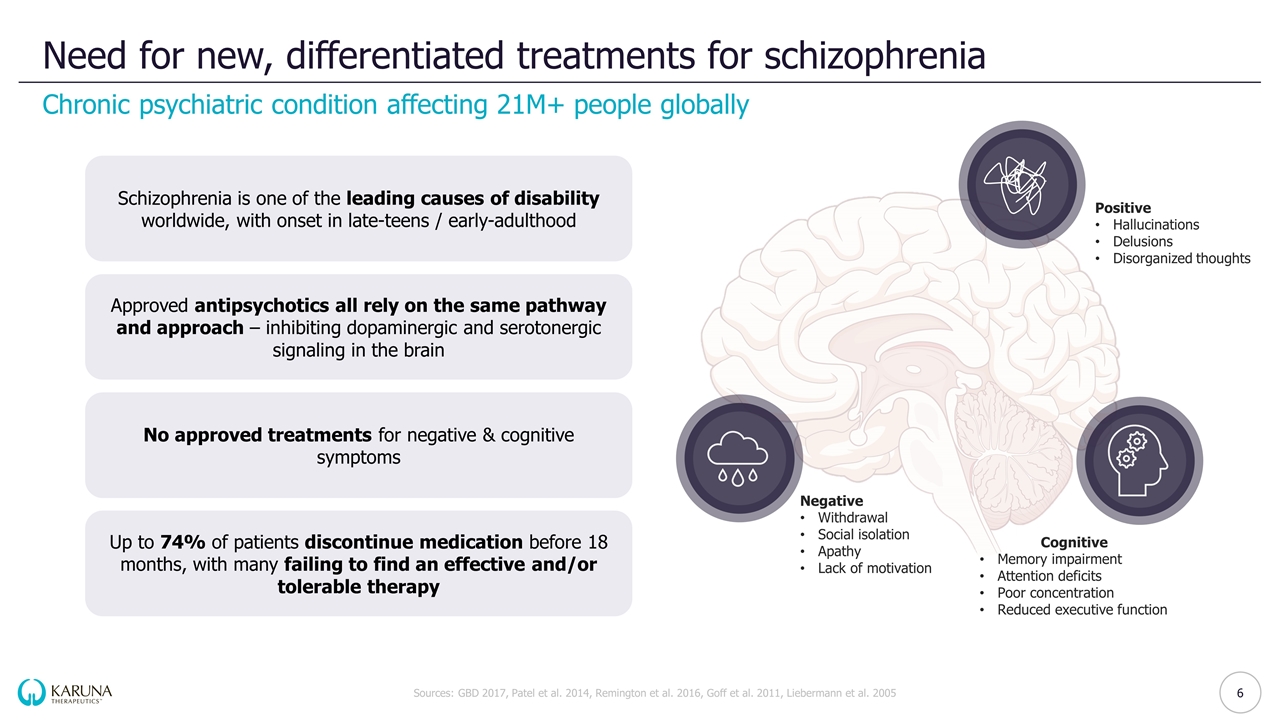
Need for new, differentiated treatments for schizophrenia Sources: GBD 2017, Patel et al. 2014, Remington et al. 2016, Goff et al. 2011, Liebermann et al. 2005 Chronic psychiatric condition affecting 21M+ people globally Schizophrenia is one of the leading causes of disability worldwide, with onset in late-teens / early-adulthood No approved treatments for negative & cognitive symptoms Up to 74% of patients discontinue medication before 18 months, with many failing to find an effective and/or tolerable therapy Approved antipsychotics all rely on the same pathway and approach – inhibiting dopaminergic and serotonergic signaling in the brain Positive Hallucinations Delusions Disorganized thoughts Negative Withdrawal Social isolation Apathy Lack of motivation Cognitive Memory impairment Attention deficits Poor concentration Reduced executive function
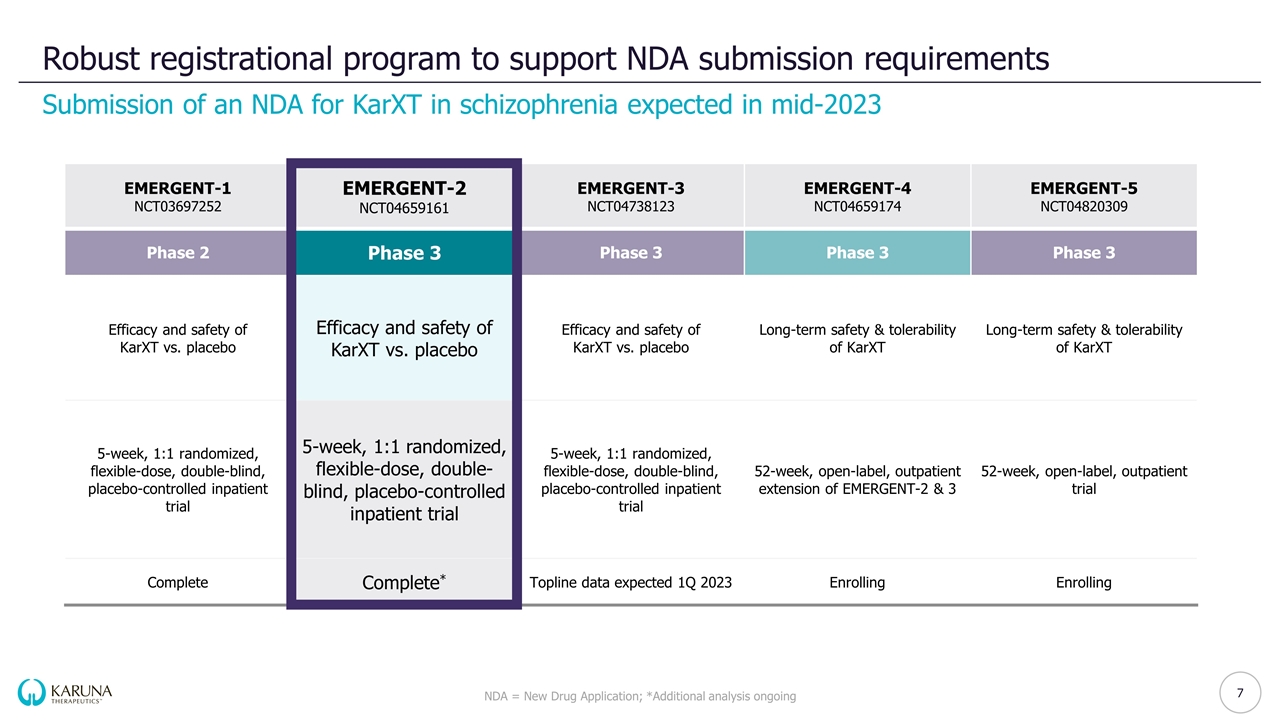
Robust registrational program to support NDA submission requirements Submission of an NDA for KarXT in schizophrenia expected in mid-2023 NDA = New Drug Application; *Additional analysis ongoing EMERGENT-1 NCT03697252 EMERGENT-2 NCT04659161 EMERGENT-3 NCT04738123 EMERGENT-4 NCT04659174 EMERGENT-5 NCT04820309 Phase 2 Phase 3 Phase 3 Phase 3 Phase 3 Efficacy and safety of KarXT vs. placebo Efficacy and safety of KarXT vs. placebo Efficacy and safety of KarXT vs. placebo Long-term safety & tolerability of KarXT Long-term safety & tolerability of KarXT 5-week, 1:1 randomized, flexible-dose, double-blind, placebo-controlled inpatient trial 5-week, 1:1 randomized, flexible-dose, double-blind, placebo-controlled inpatient trial 5-week, 1:1 randomized, flexible-dose, double-blind, placebo-controlled inpatient trial 52-week, open-label, outpatient extension of EMERGENT-2 & 3 52-week, open-label, outpatient trial Complete Complete* Topline data expected 1Q 2023 Enrolling Enrolling
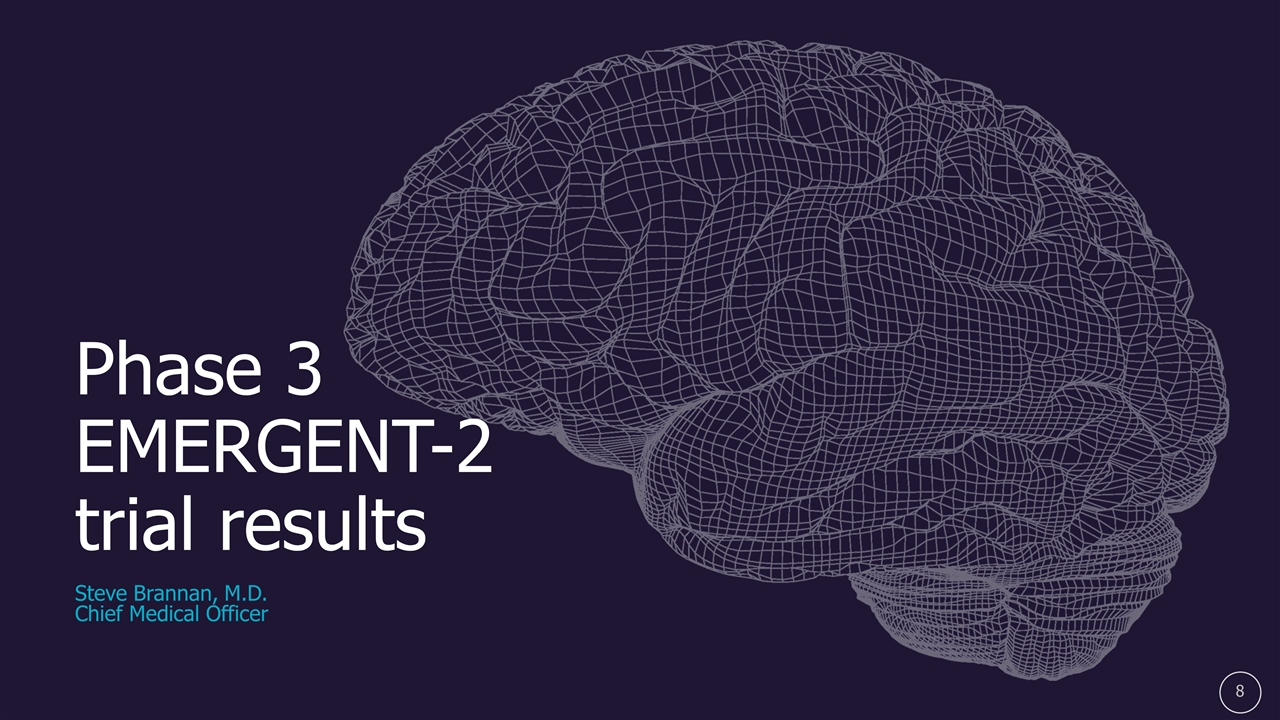
Phase 3 EMERGENT-2 trial results Steve Brannan, M.D. Chief Medical Officer
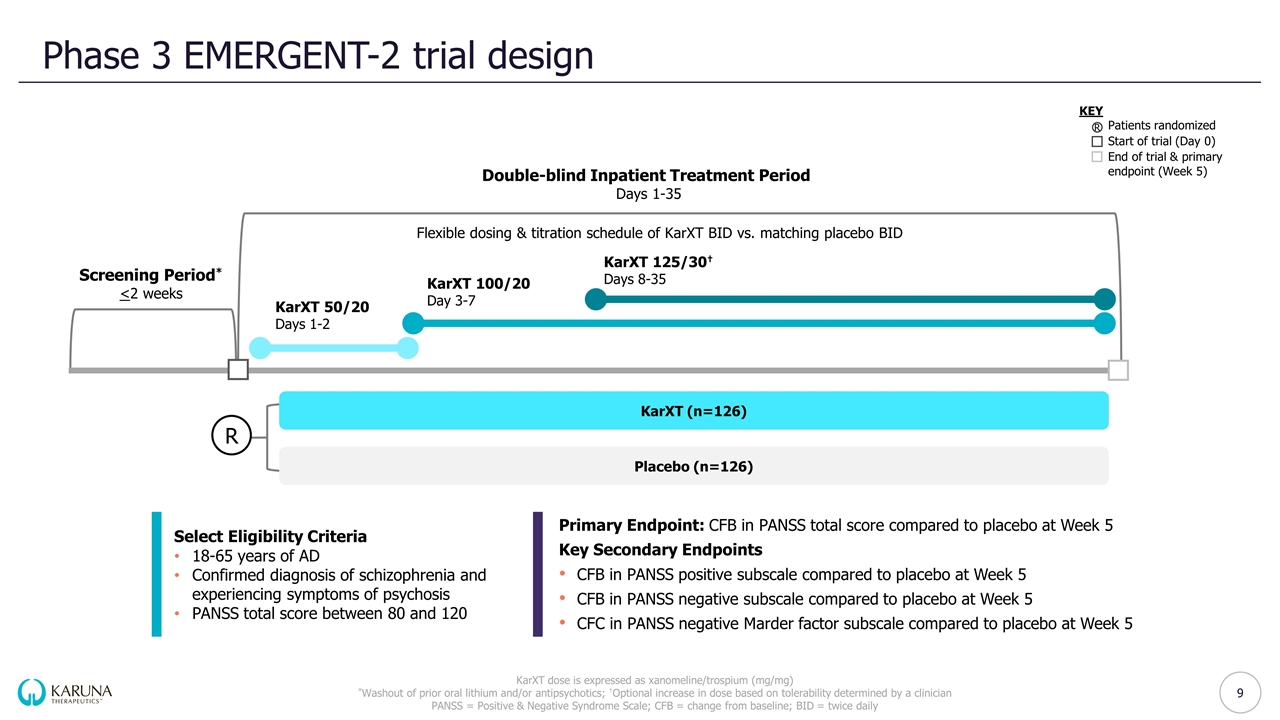
Phase 3 EMERGENT-2 trial design KarXT dose is expressed as xanomeline/trospium (mg/mg) *Washout of prior oral lithium and/or antipsychotics; †Optional increase in dose based on tolerability determined by a clinician PANSS = Positive & Negative Syndrome Scale; CFB = change from baseline; BID = twice daily Double-blind Inpatient Treatment Period Days 1-35 Screening Period* <2 weeks KarXT (n=126) Placebo (n=126) KEY Patients randomized Start of trial (Day 0) End of trial & primary endpoint (Week 5) Flexible dosing & titration schedule of KarXT BID vs. matching placebo BID R KarXT 50/20 Days 1-2 KarXT 100/20 Day 3-7 KarXT 125/30† Days 8-35 R Select Eligibility Criteria 18-65 years of AD Confirmed diagnosis of schizophrenia and experiencing symptoms of psychosis PANSS total score between 80 and 120 Primary Endpoint: CFB in PANSS total score compared to placebo at Week 5 Key Secondary Endpoints CFB in PANSS positive subscale compared to placebo at Week 5 CFB in PANSS negative subscale compared to placebo at Week 5 CFC in PANSS negative Marder factor subscale compared to placebo at Week 5
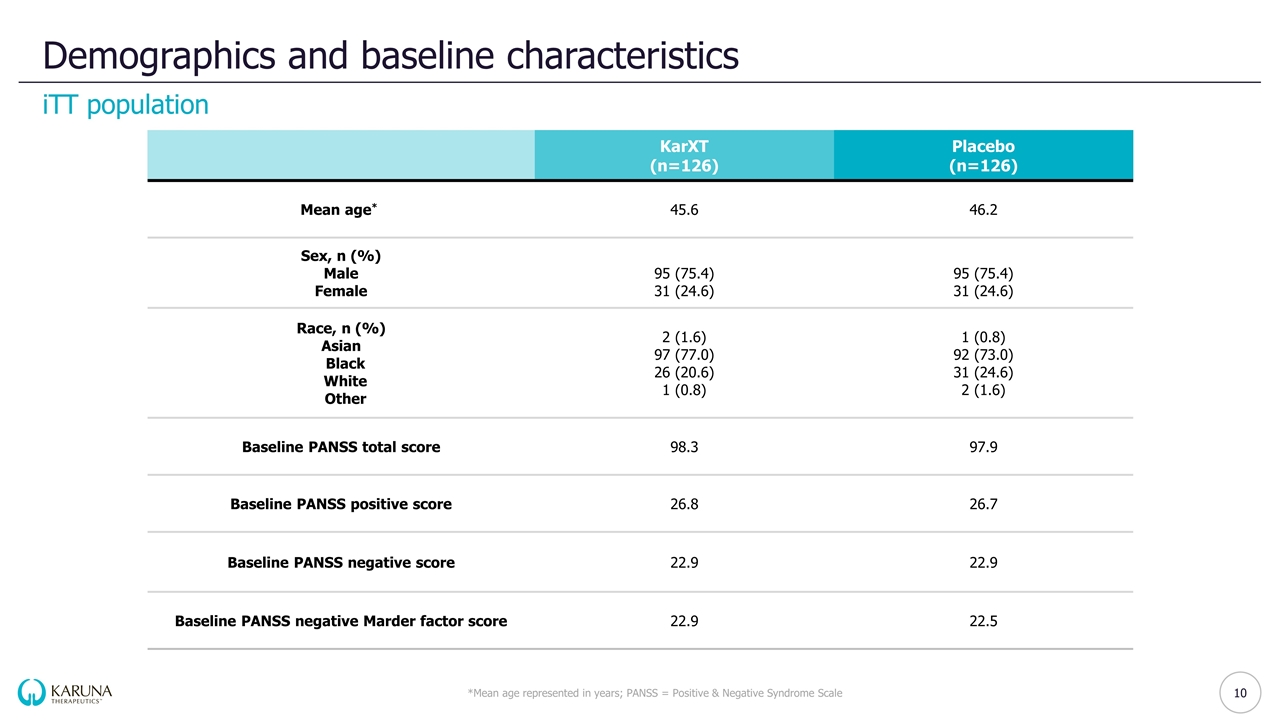
Demographics and baseline characteristics *Mean age represented in years; PANSS = Positive & Negative Syndrome Scale iTT population KarXT (n=126) Placebo (n=126) Mean age* 45.6 46.2 Sex, n (%) Male Female 95 (75.4) 31 (24.6) 95 (75.4) 31 (24.6) Race, n (%) Asian Black White Other 2 (1.6) 97 (77.0) 26 (20.6) 1 (0.8) 1 (0.8) 92 (73.0) 31 (24.6) 2 (1.6) Baseline PANSS total score 98.3 97.9 Baseline PANSS positive score 26.8 26.7 Baseline PANSS negative score 22.9 22.9 Baseline PANSS negative Marder factor score 22.9 22.5
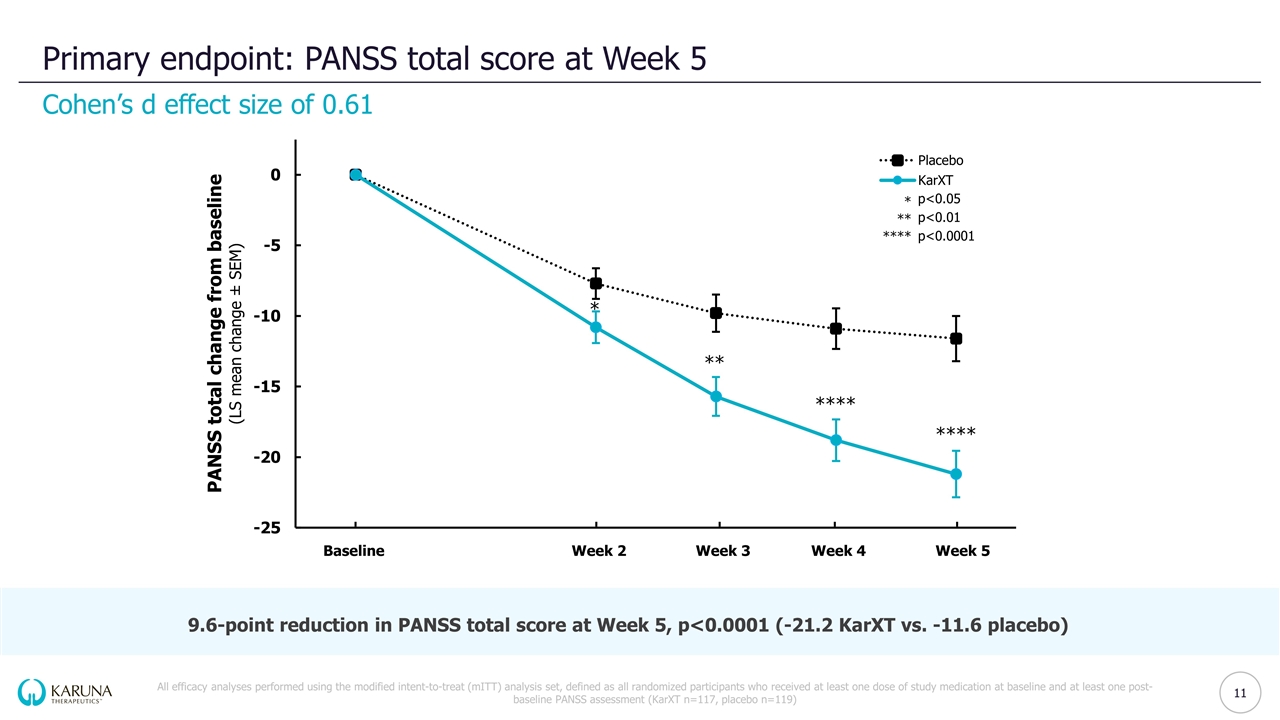
Primary endpoint: PANSS total score at Week 5 All efficacy analyses performed using the modified intent-to-treat (mITT) analysis set, defined as all randomized participants who received at least one dose of study medication at baseline and at least one post-baseline PANSS assessment (KarXT n=117, placebo n=119) Cohen’s d effect size of 0.61 Baseline Week 2 Week 3 Week 4 Week 5 **** **** ** * 9.6-point reduction in PANSS total score at Week 5, p<0.0001 (-21.2 KarXT vs. -11.6 placebo) * ** **** p<0.05 p<0.01 p<0.0001
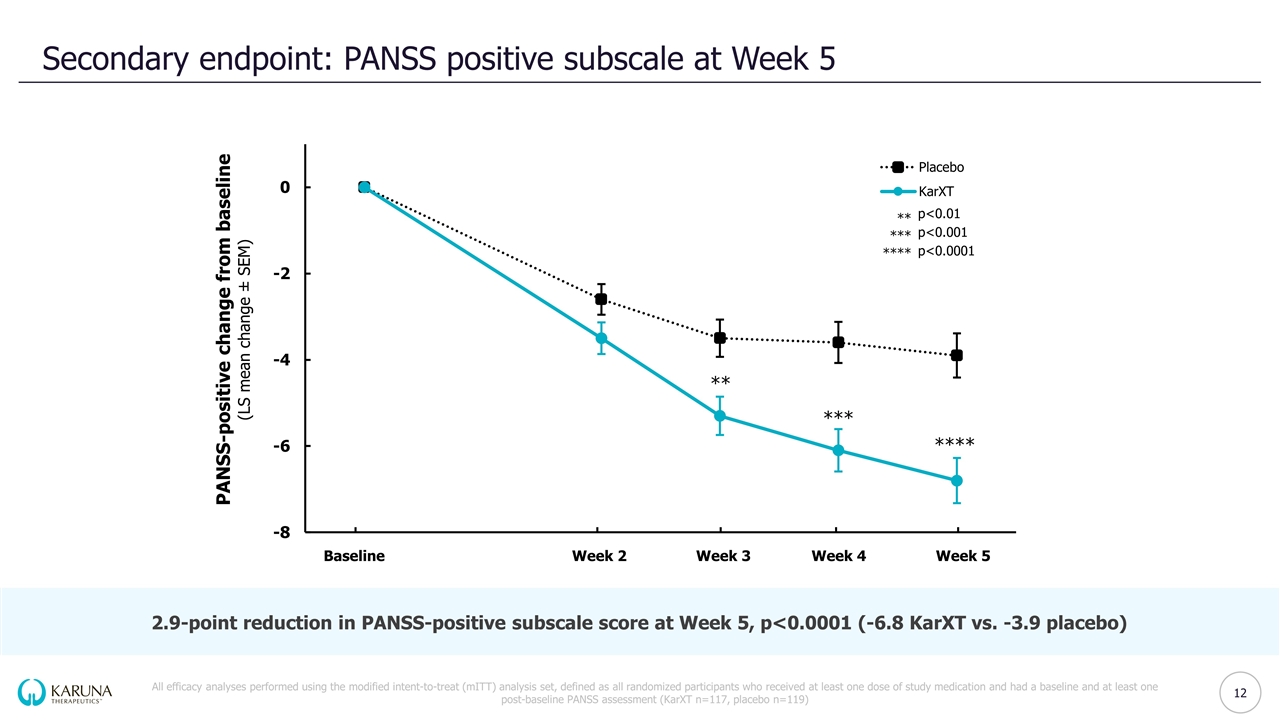
Secondary endpoint: PANSS positive subscale at Week 5 All efficacy analyses performed using the modified intent-to-treat (mITT) analysis set, defined as all randomized participants who received at least one dose of study medication and had a baseline and at least one post-baseline PANSS assessment (KarXT n=117, placebo n=119) Baseline Week 2 Week 3 Week 4 Week 5 **** *** ** 2.9-point reduction in PANSS-positive subscale score at Week 5, p<0.0001 (-6.8 KarXT vs. -3.9 placebo) ** *** **** p<0.01 p<0.001 p<0.0001
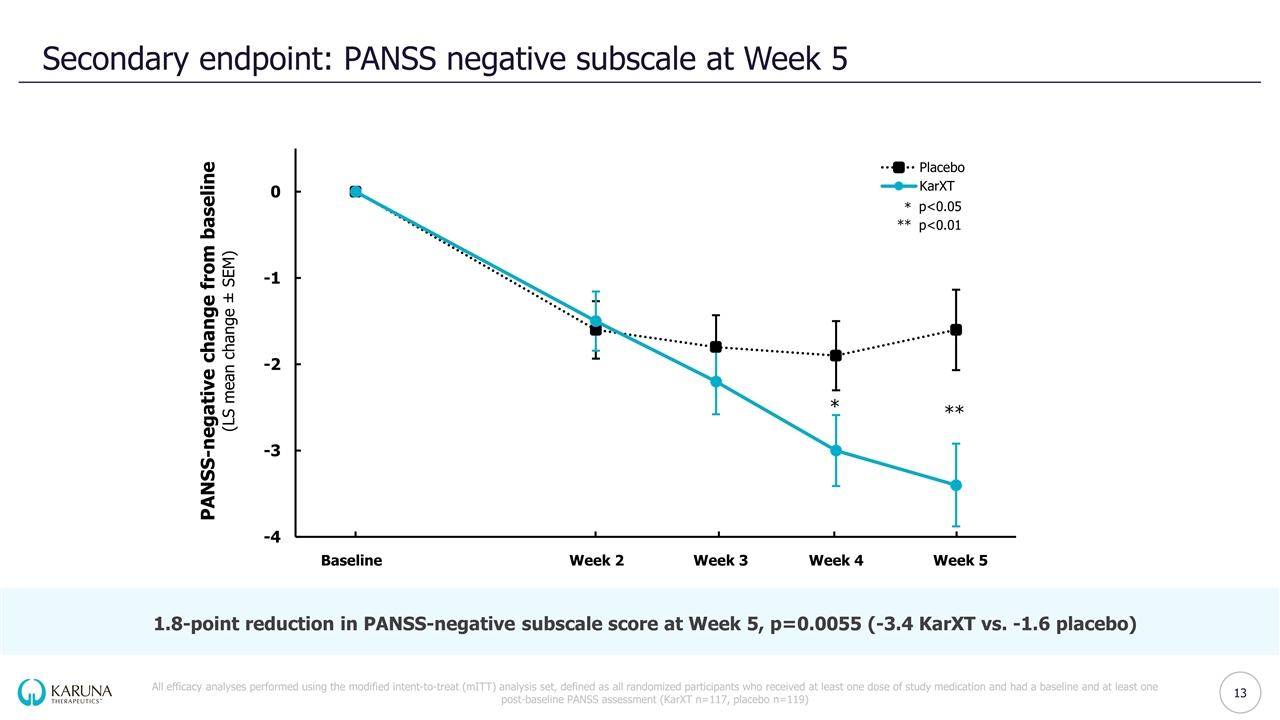
Secondary endpoint: PANSS negative subscale at Week 5 All efficacy analyses performed using the modified intent-to-treat (mITT) analysis set, defined as all randomized participants who received at least one dose of study medication and had a baseline and at least one post-baseline PANSS assessment (KarXT n=117, placebo n=119) Baseline Week 2 Week 3 Week 4 Week 5 ** * 1.8-point reduction in PANSS-negative subscale score at Week 5, p=0.0055 (-3.4 KarXT vs. -1.6 placebo) p<0.05 p<0.01 * **
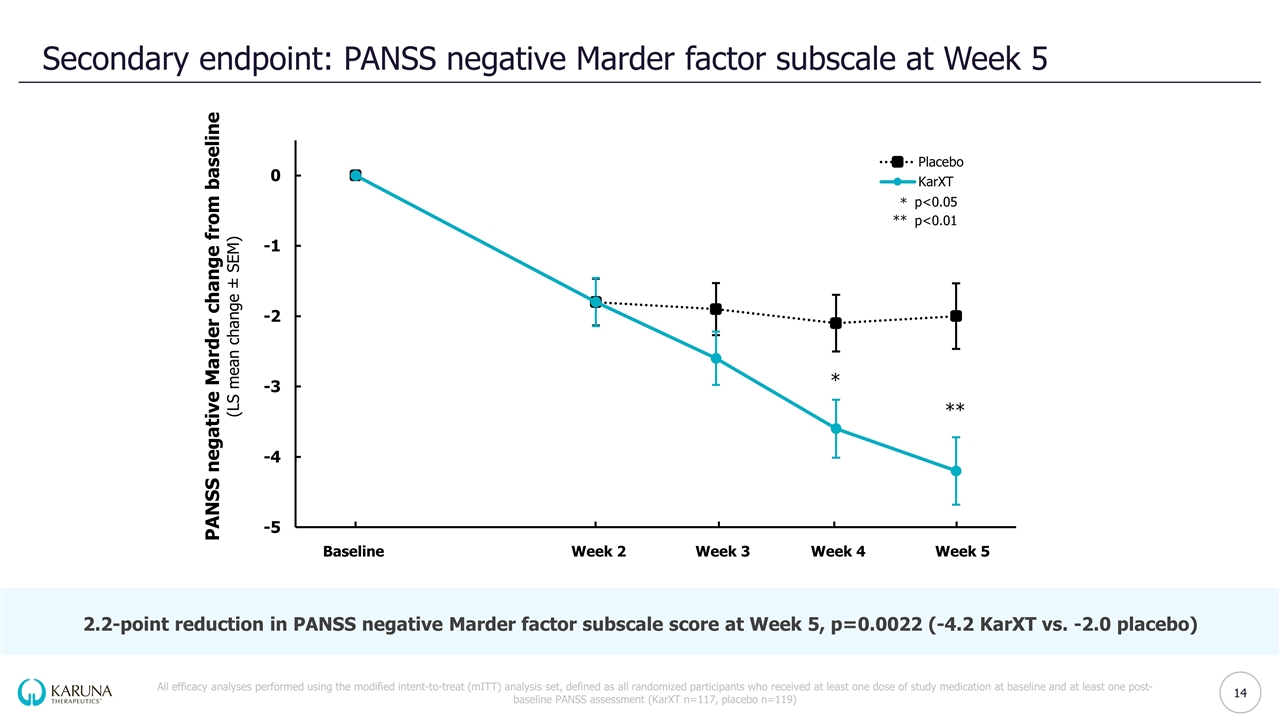
Secondary endpoint: PANSS negative Marder factor subscale at Week 5 All efficacy analyses performed using the modified intent-to-treat (mITT) analysis set, defined as all randomized participants who received at least one dose of study medication at baseline and at least one post-baseline PANSS assessment (KarXT n=117, placebo n=119) Baseline Week 2 Week 3 Week 4 Week 5 ** * 2.2-point reduction in PANSS negative Marder factor subscale score at Week 5, p=0.0022 (-4.2 KarXT vs. -2.0 placebo) p<0.05 p<0.01 * **
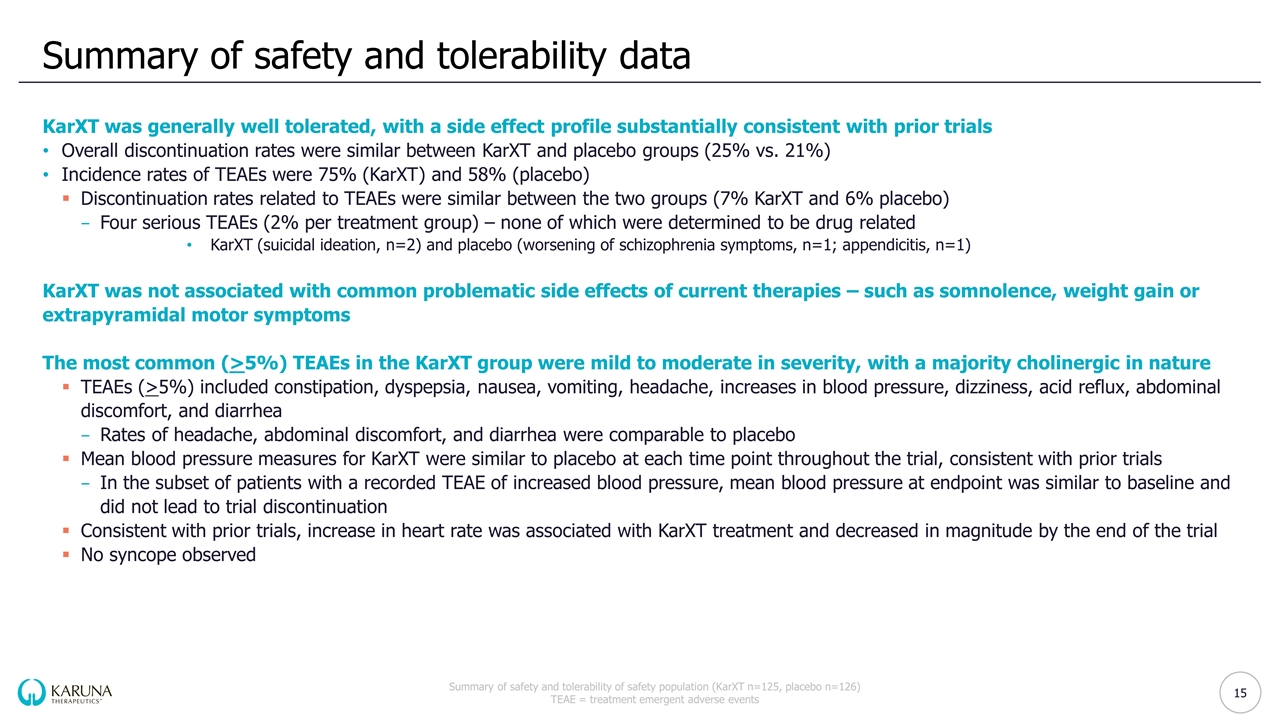
Summary of safety and tolerability data KarXT was generally well tolerated, with a side effect profile substantially consistent with prior trials Overall discontinuation rates were similar between KarXT and placebo groups (25% vs. 21%) Incidence rates of TEAEs were 75% (KarXT) and 58% (placebo) Discontinuation rates related to TEAEs were similar between the two groups (7% KarXT and 6% placebo) Four serious TEAEs (2% per treatment group) – none of which were determined to be drug related KarXT (suicidal ideation, n=2) and placebo (worsening of schizophrenia symptoms, n=1; appendicitis, n=1) KarXT was not associated with common problematic side effects of current therapies – such as somnolence, weight gain or extrapyramidal motor symptoms The most common (>5%) TEAEs in the KarXT group were mild to moderate in severity, with a majority cholinergic in nature TEAEs (>5%) included constipation, dyspepsia, nausea, vomiting, headache, increases in blood pressure, dizziness, acid reflux, abdominal discomfort, and diarrhea Rates of headache, abdominal discomfort, and diarrhea were comparable to placebo Mean blood pressure measures for KarXT were similar to placebo at each time point throughout the trial, consistent with prior trials In the subset of patients with a recorded TEAE of increased blood pressure, mean blood pressure at endpoint was similar to baseline and did not lead to trial discontinuation Consistent with prior trials, increase in heart rate was associated with KarXT treatment and decreased in magnitude by the end of the trial No syncope observed Summary of safety and tolerability of safety population (KarXT n=125, placebo n=126) TEAE = treatment emergent adverse events
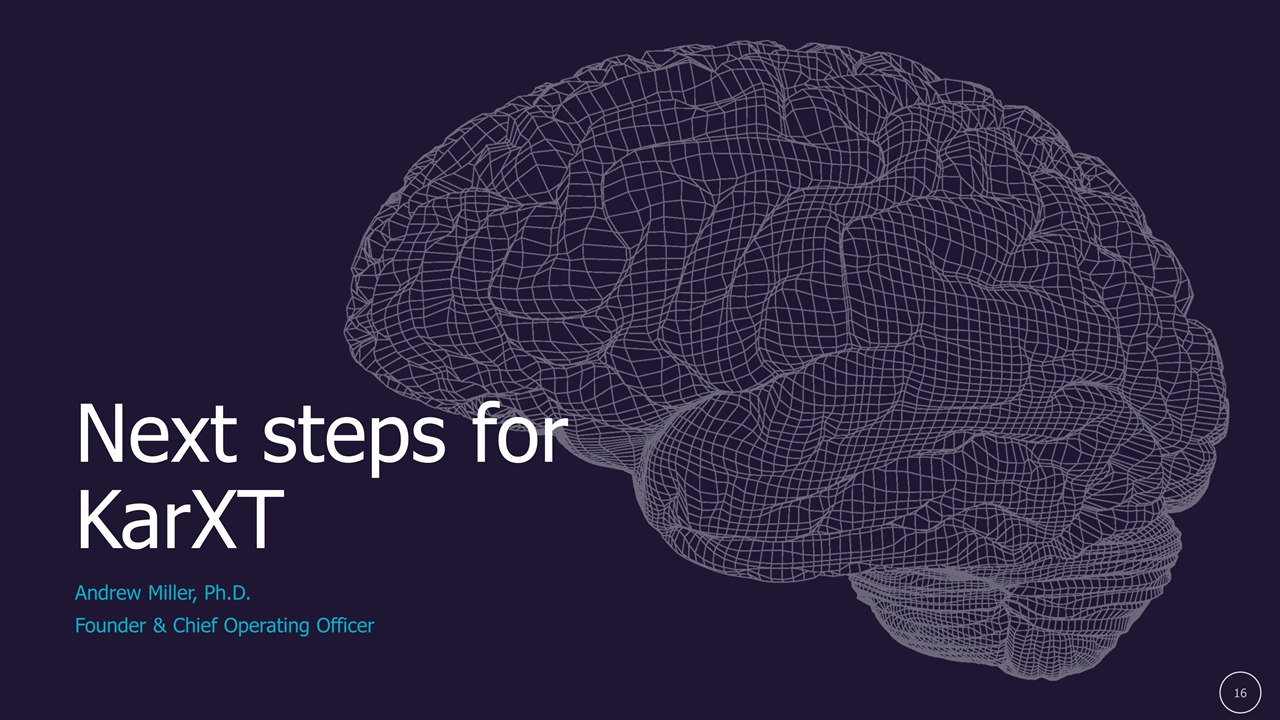
Next steps for KarXT Andrew Miller, Ph.D. Founder & Chief Operating Officer
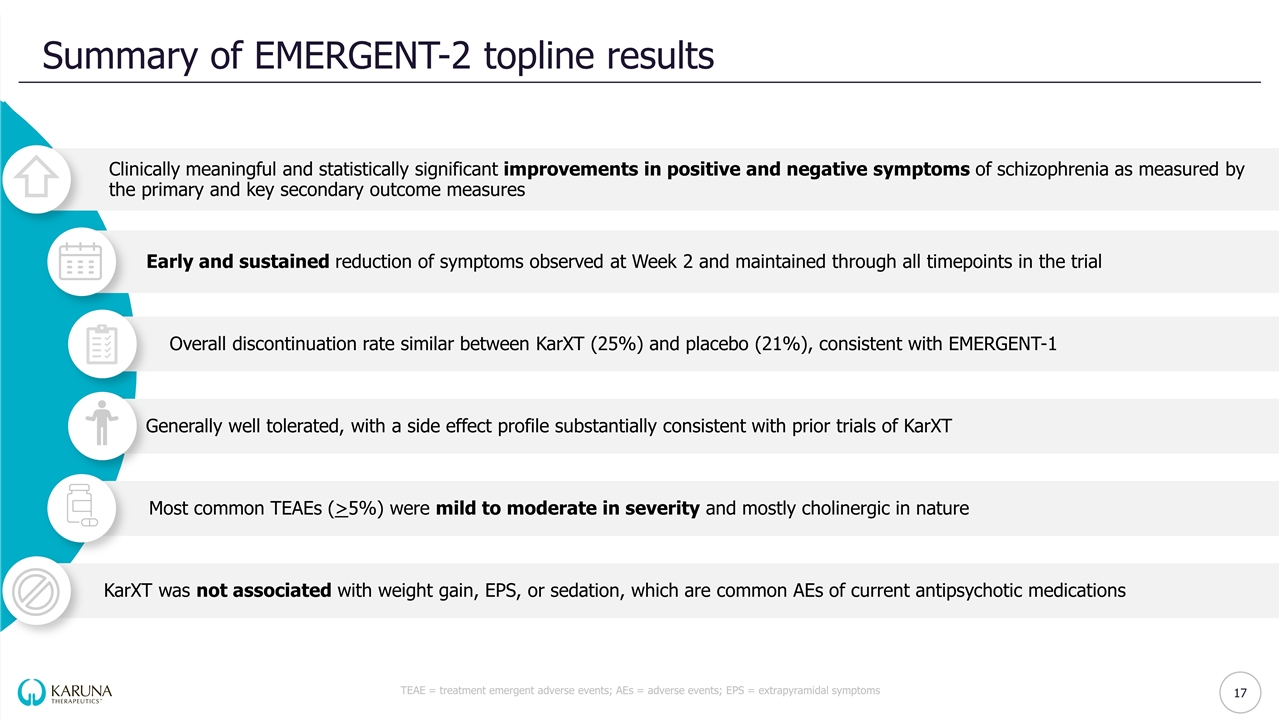
Summary of EMERGENT-2 topline results TEAE = treatment emergent adverse events; AEs = adverse events; EPS = extrapyramidal symptoms Clinically meaningful and statistically significant improvements in positive and negative symptoms of schizophrenia as measured by the primary and key secondary outcome measures Early and sustained reduction of symptoms observed at Week 2 and maintained through all timepoints in the trial KarXT was not associated with weight gain, EPS, or sedation, which are common AEs of current antipsychotic medications Most common TEAEs ( > 5%) were mild to moderate in severity and mostly cholinergic in nature Generally well tolerated, with a side effect profile substantially consistent with prior trials of KarXT Overall discontinuation rate similar between KarXT (25%) and placebo (21%), consistent with EMERGENT-1
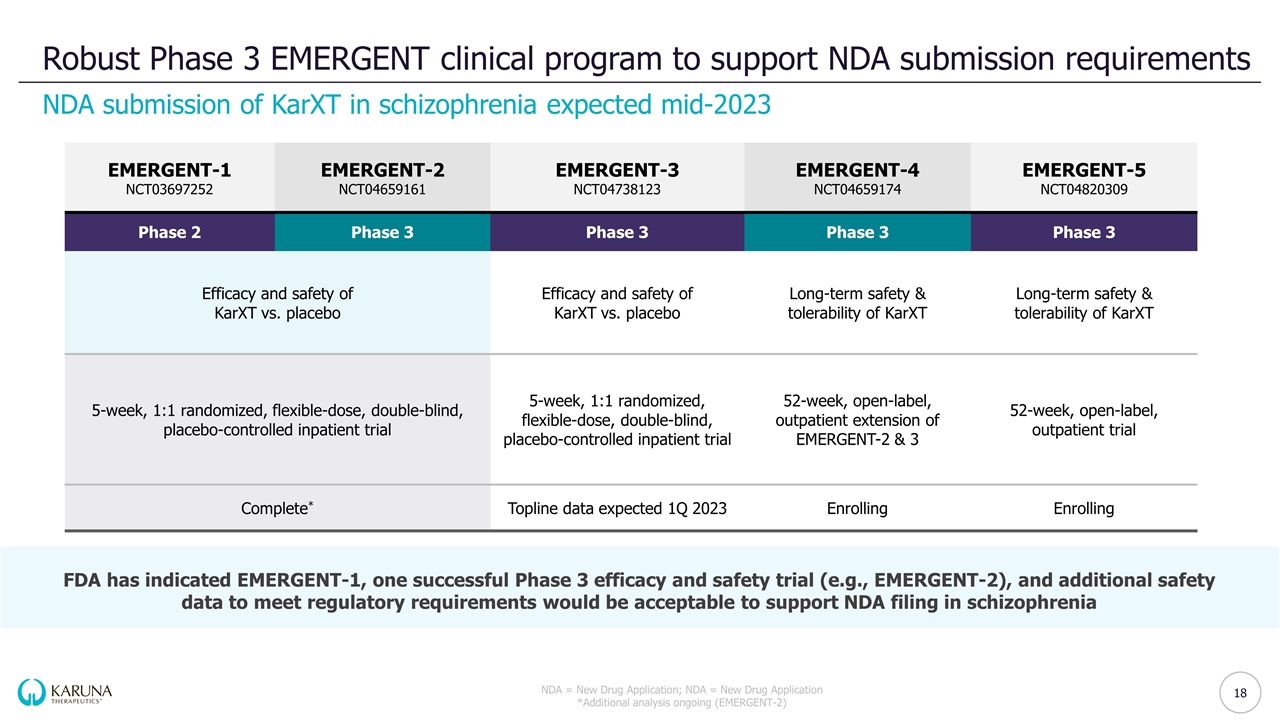
Robust Phase 3 EMERGENT clinical program to support NDA submission requirements NDA submission of KarXT in schizophrenia expected mid-2023 NDA = New Drug Application; NDA = New Drug Application *Additional analysis ongoing (EMERGENT-2) FDA has indicated EMERGENT-1, one successful Phase 3 efficacy and safety trial (e.g., EMERGENT-2), and additional safety data to meet regulatory requirements would be acceptable to support NDA filing in schizophrenia EMERGENT-1 NCT03697252 EMERGENT-2 NCT04659161 EMERGENT-3 NCT04738123 EMERGENT-4 NCT04659174 EMERGENT-5 NCT04820309 Phase 2 Phase 3 Phase 3 Phase 3 Phase 3 Efficacy and safety of KarXT vs. placebo Efficacy and safety of KarXT vs. placebo Efficacy and safety of KarXT vs. placebo Long-term safety & tolerability of KarXT Long-term safety & tolerability of KarXT 5-week, 1:1 randomized, flexible-dose, double-blind, placebo-controlled inpatient trial 5-week, 1:1 randomized, flexible-dose, double-blind, placebo-controlled inpatient trial 5-week, 1:1 randomized, flexible-dose, double-blind, placebo-controlled inpatient trial 52-week, open-label, outpatient extension of EMERGENT-2 & 3 52-week, open-label, outpatient trial Complete* Complete Topline data expected 1Q 2023 Enrolling Enrolling
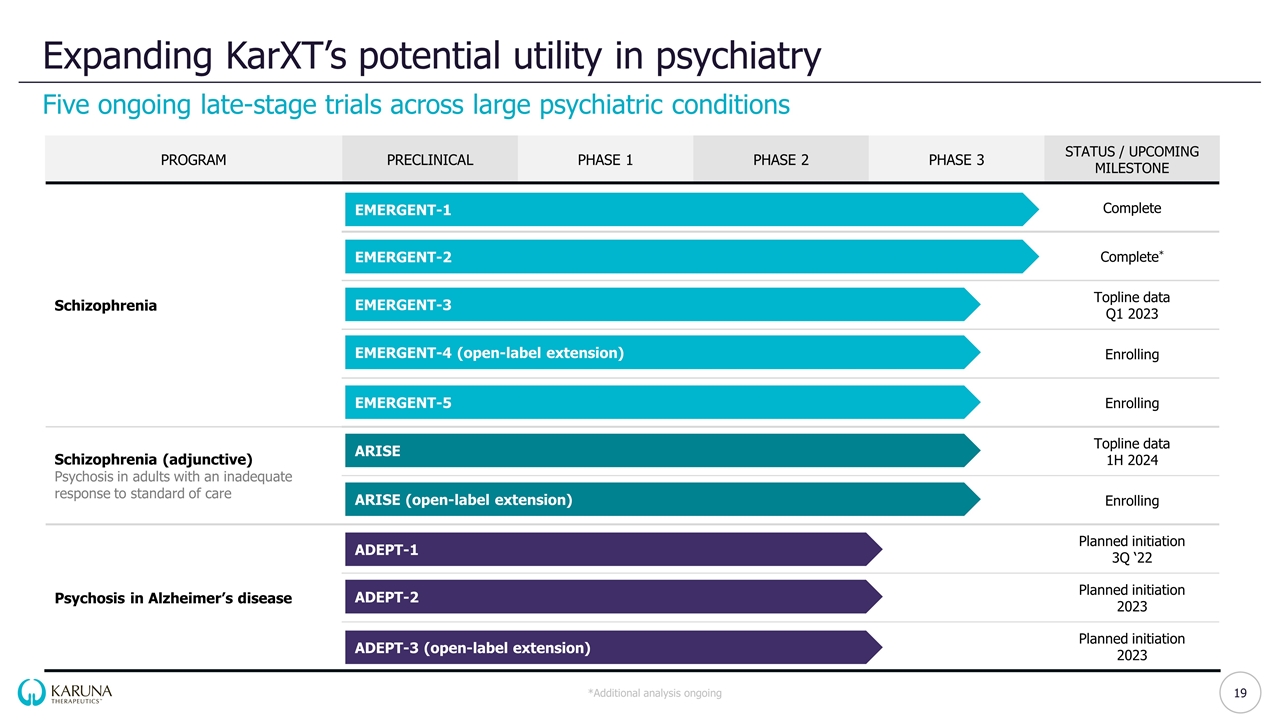
Expanding KarXT’s potential utility in psychiatry *Additional analysis ongoing Five ongoing late-stage trials across large psychiatric conditions PROGRAM PRECLINICAL PHASE 1 PHASE 2 PHASE 3 STATUS / UPCOMING MILESTONE Schizophrenia Complete Schizophrenia Complete* Topline data Q1 2023 Enrolling Enrolling Schizophrenia (adjunctive) Psychosis in adults with an inadequate response to standard of care Topline data 1H 2024 Enrolling Psychosis in Alzheimer’s disease Planned initiation 3Q ‘22 Planned initiation 2023 Planned initiation 2023 EMERGENT-2 EMERGENT-3 EMERGENT-4 (open-label extension) EMERGENT-5 ARISE ADEPT-1 ARISE (open-label extension) ADEPT-2 ADEPT-3 (open-label extension) EMERGENT-1
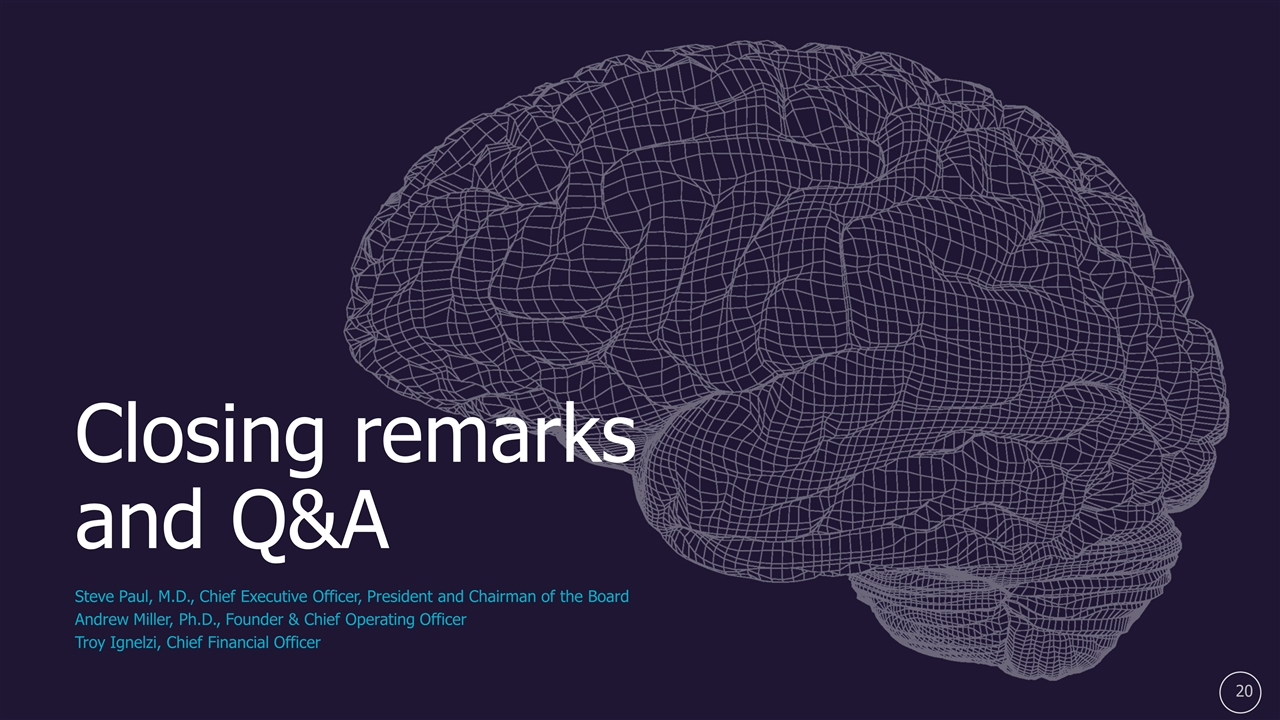
Closing remarks and Q&A Steve Paul, M.D., Chief Executive Officer, President and Chairman of the Board Andrew Miller, Ph.D., Founder & Chief Operating Officer Troy Ignelzi, Chief Financial Officer
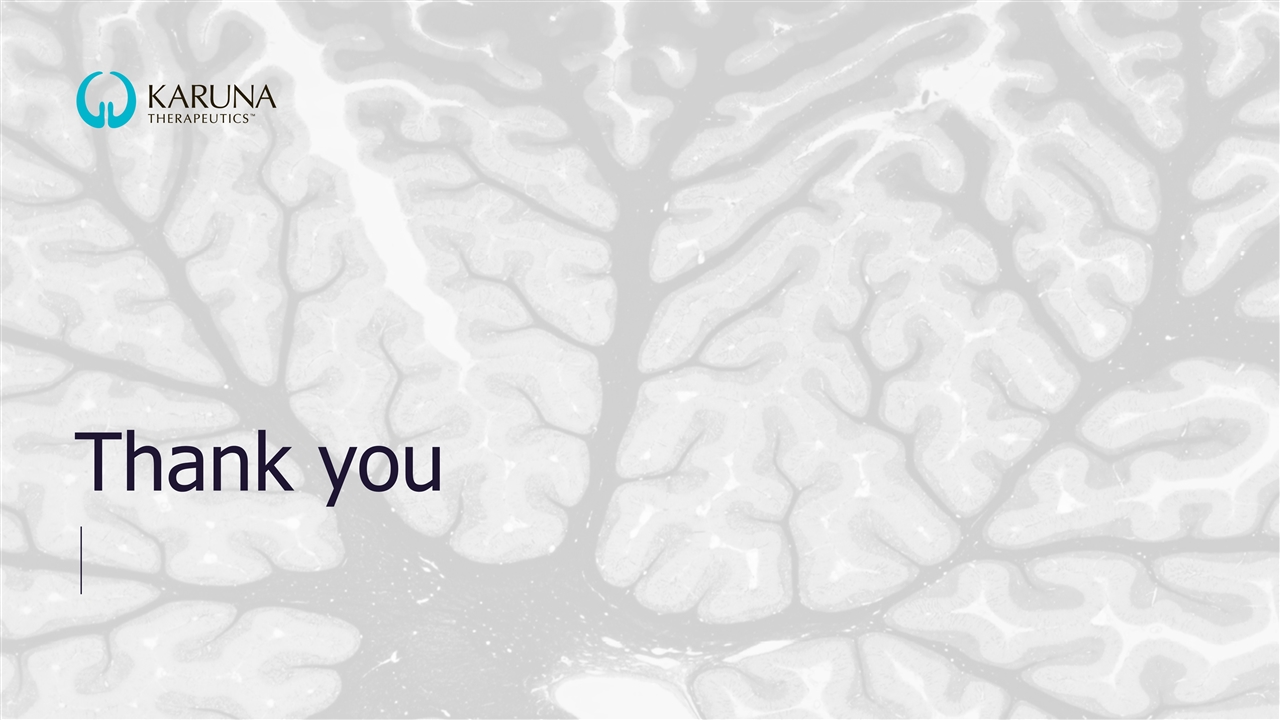
Thank you




















